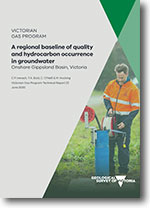VGP Technical Report 22 - A regional baseline of quality and hydrocarbon occurrence in groundwater Onshore Gippsland Basin, Victoria
 |
| |||||||||||||||
Product description:About the Victorian Gas Program: The Victorian Gas Program (VGP) is a comprehensive science-led program, incorporating geoscientific and environmental research to assess the risks, benefits and impacts of potential onshore conventional gas exploration and production. The program is also investigating the potential for further discoveries of onshore conventional and offshore gas in the Otway and Gippsland geological basins and assessing the feasibility of additional onshore underground gas storage in depleted reservoirs around the Port Campbell area. The VGP includes an extensive, proactive and phased community and stakeholder engagement program, through which the results of the scientific studies are being communicated. Executive summary: A regional assessment of groundwater chemistry, environmental isotopes, dissolved methane (CH4), and longer-chain hydrocarbon occurrence across the Gippsland Basin has been conducted as part of the Victorian Gas Program (VGP). These baseline groundwater measurements were acquired from State Observation Bore Network (SOBN) bores using low-flow sampling techniques. This baseline study is the most complete deep groundwater chemistry dataset collected in the Gippsland Basin by the Victorian Government to date, building on existing data and providing a baseline measure of groundwater conditions. As part of the VGP environmental studies program, Geological Survey of Victoria (GSV) hydrogeologists conducted baseline characterisation studies of the groundwater and atmosphere in the Gippsland Basin to determine current environmental conditions. This new groundwater chemistry dataset may support regulation of the sector by equipping government with a baseline it can use to monitor and report on any industry impacts. Groundwater is water that is stored in porous geological formations. Groundwater is more heavily relied upon than surface water in many parts of the world and is used as the main source of drinking water in many places in Australia. Thus, it is important to understand how water enters an aquifer, moves through the water-bearing rock and how long it resides underground, so that the resource can be protected from contamination and overuse. Hydrogeologists use geochemical methods to characterise groundwater quality and understand local and regional groundwater processes (such as where the water has come from and how long ago). Results for this project may be used by groundwater users, industry, water suppliers and regulators. The groundwater sampling equipment and methods used here are common to many groundwater geochemical studies conducted in Australia and internationally. In total, 22 samples were collected across the Gippsland Basin covering a depth range of 15 m to 1100 m. All samples were collected from groundwater bores that are part of the Victorian SOBN. All groundwater samples were analysed for 144 analytes. Generally, the groundwater quality of the samples collected in the Gippsland Basin is good, with localised areas of salinity up to 2880 mg/L Total Dissolved Solids (TDS). Major ion chemistry shows that the groundwater quality sampled is of suitable quality for irrigation and stock use, and variable quality for drinking water use. Sample results from major ion chemistry show that evapotranspiration and groundwater mixing are the main controls on the groundwater chemistry in the Gippsland Basin. Stable water isotopes revealed groundwater recharge via rainfall is the main mechanism of replenishing the aquifers in the basin. Groundwater residence times in the basin did not display a significant trend with depth, with radiocarbon groundwater ages ranging from around 200 to around 25,000 years. Methane occurs throughout the groundwater of the Gippsland Basin, where the concentration generally increases with depth. Additional data, such as the isotopic composition of the CH4 and its relationship with ethane (C2H6) suggest that most of the CH4 has been produced naturally by microbes in the groundwater. In some groundwater samples near the coast, additional data suggests that there may be a natural gas component in the CH4. Longer-chain hydrocarbons and other petroleum by-products were detected in very low concentrations in most of the samples. The majority of these can be attributed to contamination during either bore construction or sampling, however there are two samples that suggest natural occurrence of these compounds. Bibliographic reference: Iverach, C.P., O’Neill, C., Bold, T.A. & Hocking, M., 2020. A regional baseline of quality and hydrocarbon occurrence in groundwater Onshore Gippsland Basin, Victoria. Victorian Gas Program Technical Report 22. Geological Survey of Victoria. Download: The downloadable version of this report is supplied in PDF format (12.5 MB), accessible version (DOCX 6.4 MB) & Att 1 data XLSX (82 kB). Related products:
| ||||||||||||||||


